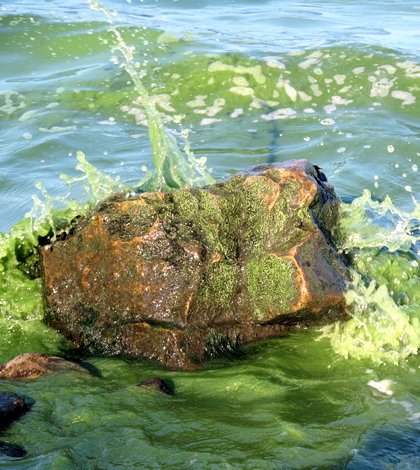Lake Erie has grown more vulnerable to algae blooms; tougher nutrient targets needed

After numerous cyanobacteria blooms on Lake Erie over the past decades, including one that crippled Toledo’s drinking water infrastructure in August, it’s easy to label these events as old news. But new research suggests that we’ll be hearing about bigger, badder blooms more frequently.
A new study published in Water Resources Research shows that cyanobacteria blooms in western Lake Erie have grown dramatically since 2002 due to the bacteria’s increased sensitivity to phosphorus loads. The findings come from an analysis of various factors within computer modeling of cyanobacteria blooms.
“What we were trying to do was develop a model that we could use to forecast the size of the cyanobacteria blooms that occur in Lake Erie each year,” said Daniel Obenour, assistant professor at North Carolina State University and lead author of the study. The model used data from historical NASA satellite imagery and water quality sampling conducted by Heidelberg University scientists.
The researchers wanted to explore the various predictors of cyanobacteria blooms, such as temporal trends, temperature and phosphorus loads. Obenour said temperature was quickly ruled out, but phosphorus actually seemed to have an increasingly significant effect on the blooms over time.
“We’re seeing blooms initiate even when we have lower phosphorus loads,” Obenour said. “We didn’t expect to see that.”

A harmful algae bloom spreads across Lake Erie near Pelee Island in this 2009 photo. (Credit: Tom Archer, via Flickr/ CC BY-NC 2.0)
It’s not exactly clear what’s making the blooms more susceptible to phosphorus, but Obenour says one likely explanation lies in the invasion of zebra and quagga mussels in the Great Lakes. Those species are known to filter out the algae species that compete with cyanobacteria for phosphorus, leaving more of the nutrient to fuel the toxic blooms. Of course, Obenour says, that’s just one possibility.
“Until we conduct more research and more fully understand what causes this increasing susceptibility, there will be uncertainty,” he said. “There’s obviously other factors at play, and one of the purposes of this study was to quantify that uncertainty.” It’s also important, he noted, to consider the inherent uncertainty in the historical estimates of bloom sizes that informed their models.
An expanded dataset is one tool that will help the researchers better understand the predictors of cyanobacteria blooms. Obenour says they hope to add more satellite imagery spanning a longer period of time.
For the time being, however, Obenour says his research points to a bottom line that Lake Erie resource managers can’t ignore:
“Given the lake’s increased susceptibility to blooms that we’re observing, the proposed phosphorus loading targets aren’t going to be sufficient to reduce the blooms down to the desired sizes,” he said.
Top image: Lake Erie algal bloom 2011 (Credit: Brenda Culler / Ohio Department of Natural Resources)




Pingback: FishSens Magazine | Habitat Suitability for Invasive Carp in the Great Lakes Region - FishSens Magazine